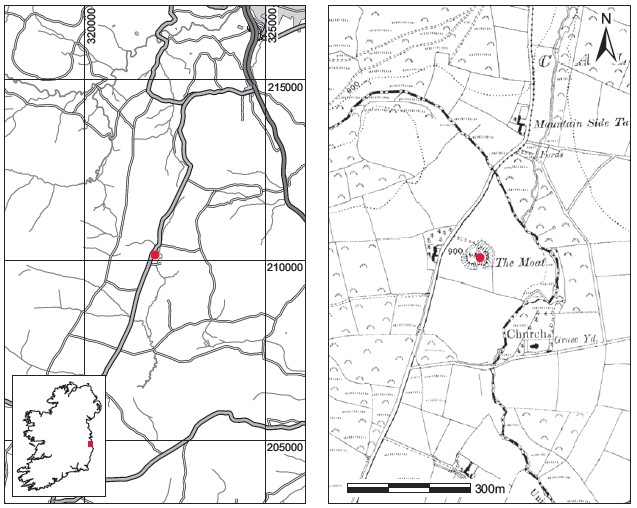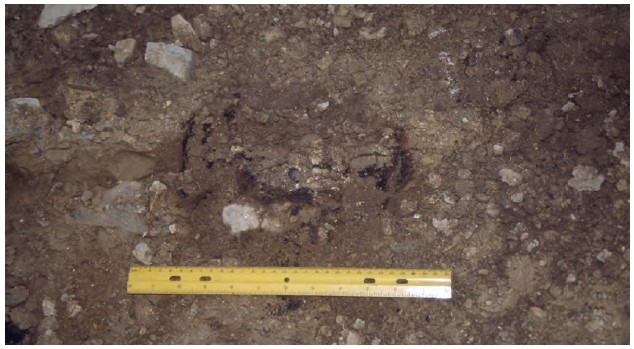1981:018 - GLASNAMULLEN, CO. WICKLOW, Wicklow
County: Wicklow
Site name: GLASNAMULLEN, CO. WICKLOW
Sites and Monuments Record No.: SMR WI012-064
Licence number: E1193
Author: RAGHNALL Ó FLOINN
Author/Organisation Address: —
Site type: Early Bronze Age graves
Period/Dating: —
ITM: E 721882m, N 710185m
Latitude, Longitude (decimal degrees): 53.128259, -6.178769
Introduction
In August 1981 two urn burials were discovered by two schoolboys near Bray, Co. Wicklow. The burials had been exposed in the section of a natural hillock called ‘The Moat’ on the Ordnance Survey maps and known locally as ‘Sutton’s Moat’. The discovery was reported to the Museum by Ms Elizabeth O’Brien, who was excavating at Ballyman, Co. Dublin, at the time. A one-day rescue excavation was undertaken by Raghnall Ó Floinn, assisted by Elizabeth O’Brien. The human remains were examined by Professor C.A. Erskine.
Location (Fig. 3.241)
The site was in the townland of Glasnamullen, north-west Co. Wicklow.375 The burials were found on the east side of ‘The Moat’, which overlooks the Vartry River. The altitude at the summit of the moat is 275m above sea level. It is situated 2km east-south-east of a circular enclosure (SMR WI012-009——) and 4km north-east of a large oval enclosure (SMR WI012- 010——). No early Bronze Age burials are listed in the SMR in this area.

Fig. 3.241—Location map, Glasnamullen, Co. Wicklow.

Pl. 65—Sketch of cist burial, Fussough, Co. Tipperary, by Revd Fr Richard Devane and Dr W.E. Callanan, 1933.

Pl. 66—View of cist 3, Ballybrennan, Co. Westmeath, during excavation, January 1946.

Pl. 67—Crouched inhumation, grave 2, Redmondstown, Co. Westmeath.

Pl. 68 —View of early Bronze Age cist, grave 2, before excavation, Sonnagh Demesne, Co. Westmeath, August 1954.

Pl. 69 —View of early Bronze Age cist, grave 2, during excavation, Sonnagh Demesne, Co. Westmeath, August 1954.

Pl. 70—View of site, Kilmurry, Co. Wexford, November 2001.

Pl. 70—View of site, Kilmurry, Co. Wexford, November 2001.

Pl. 72—Vase urn, Kilmurry, Co. Wexford.

Pl. 73—Grave 2, Kilmurry, Co. Wexford, November 2001.

Pl. 74—View of cist during excavation, Tomfarney, Co. Wexford, July 2006.

Pl. 75—Perforated flat stone and biconical baked clay bead, Tomfarney, Co. Wexford.

Fig. 3.242—Section showing graves, Glasnamullen, Co. Wicklow.
Grave 1
This burial was situated immediately under the topsod but no trace of a pit or stone lining was found (Fig. 3.242). The burial had been disturbed and sherds were scattered over an area of 0.3m2. The grave contained an inverted cordoned urn, a few fragments of cremated bone and some charcoal. Most of the contents had been quarried away but it was clear that the urn had been deposited in an inverted position. Only a very tiny amount of bone was recovered, which is unidentifiable.
Cordoned urn, 1981:300 (Fig. 3.243)
Approximately half of the rim circumference and some shoulder sherds survive. The rim appears to be vertical with a flat top. There appears to have been a cordon at the junction of the rim and body and the vessel has fractured along this line. The rim top is decorated with two rows of cord ornament, and externally it bears a design of cord-impressed chevrons bordered by pairs of horizontally applied cord ornament. The body below the rim appears to be undecorated. The fabric is coarse with large (5mm) grits, with a black core, a buff-grey internal and a brown external surface. One body sherd bears a cord impression.
Dimensions: est. D rim 21–22cm; T of rim 1.3cm.
Grave 2
This was located some 0.7m below the sod and 0.5m north of grave 1. As with grave 1, no trace of the pit was apparent in plan or section (Fig. 3.242). An irregular slab measuring 0.5m by 0.5m had been placed immediately over the inverted vessel but no stone lining was apparent. The pit contained an inverted collared urn and a cremation of an adult individual (1981:298). The capstone had shifted under its own weight and had crushed the lower portion of the urn. The rim, neck and contents of the urn were recovered intact.
Collared urn, 1981:299 (Fig. 3.243)
This vessel has been restored except for the base. Very coarse fabric with grits of broken, finetextured stone and small pebbles of milky quartz; brown external surface. The rim bears a broad collar with an internal bevel. The neck is concave and the body narrows towards the base. The rim top bears radially disposed cord ornament. The exterior rim is covered in closely set vertical chevrons of cord ornament. The neck is decorated with a lattice pattern of

Fig. 3.243—Ceramic vessels, Glasnamullen, Co. Wicklow.
HUMAN REMAINS
C.A. ERSKINE
Grave 2 (1981:298) was a collection of completely cremated fragments of adult skeleton; the fragments were mostly less than 1cm, although a smaller proportion measured 2–5cm. There were six fragments of teeth. Small pieces of vault of skull were recognisable.
PETROLOGY OF THE CERAMICS AND CAPSTONE
J.S. JACKSON
Collared urn, grave 2 (1981:299)
The ‘grog’ used in the urn to prevent massive shrinkage during firing and to ensure that shrinkage was localised and controlled in the clay consists of broken, fine-textured stone and small pebbles of milky quartz, with predominant (perhaps 95% or so) dark, melanocratic and broken in order to expose fresh surfaces for inspection. The texture is fine and a reliable identification is impossible without microscopic examination of a thin section. The material is certainly not granite. It could be variolite, an outcrop of which occurs near Derrylowery to the south of Roundwood and in the general area of the find-spot. A few fragments of a finetextured granite are also present: flakes of white mica (muscovite) are very common.
Fragment of capstone of grave 2
The material is a green gritstone of Lower Palaeozoic lithology and, as such, could be immediately local, coming from the Bray Series of the Calary Plateau.
375. Parish of Calary, barony of Ballinacor North. SMR WI012-064——. IGR 321958 210154. An earlier edition of the SMR lists the motte as site no. WI012-011, but this has been delisted in the latest edition.
